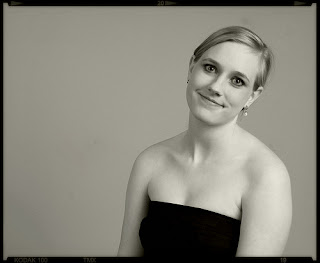Light
 I dislike most of the "strobist" portraiture I've seen. It seems as though many photographers use raw lighting without any modifiers to soften it. Perhaps that is the "modern" look to photography, but I much prefer my images to be lit with a more diffused light. In my opinion, the lighting should never overpower the image, the subject, or the message (assuming there is one) of a picture. If it does, the harsh light is like a shriek of a turpentined feline in a violin concerto. Studio lighting should imitate natural light in my opinion, and the closer it mimics it, the better. Thoughts?
I dislike most of the "strobist" portraiture I've seen. It seems as though many photographers use raw lighting without any modifiers to soften it. Perhaps that is the "modern" look to photography, but I much prefer my images to be lit with a more diffused light. In my opinion, the lighting should never overpower the image, the subject, or the message (assuming there is one) of a picture. If it does, the harsh light is like a shriek of a turpentined feline in a violin concerto. Studio lighting should imitate natural light in my opinion, and the closer it mimics it, the better. Thoughts?Labels: Photographs, Strobist





7 Comments:
I think the lighting looks natural enough. I've always found that the intensity of the light doesn't really make it unnatural, it's the direction. If it's obviously and indoor portrait, having lights coming from all directions make it look fabricated. In that pic you have your main light source on one side and just a hint on fill anywhere else. That gives the illusion of a window.
I've used the rule that the stronger the main light I want to use, the weaker the fills need to be. With a very intense main, I'll have almost nonexistant (or actual nonexistant) fills and go for a "next to a open window in the late afternoon" look.
But that's just me and sometimes reality is not my friend...
I think what you do with a camera is magic. I'm a beginner with a cheap little camera. Your advice has been much appreciated as I've learned.
I prefer softer, diffused and/or reflected light as well. I haven't had much experience in studio lighting (just the digital photography class I took last semester), but it seems to get harsh when you try to eliminate all the shadows.
Whatever you are doing for your photos, works well. I'm impressed.
I think that too much of any one style becomes monotonous. Perhaps what you are also observing is a formulaic approach to posturing the model as well. I notice that you like to try all types of posture and expression--whereas some other photographers run out of models looking to change only the subject, instead of how it is presented.
I personally like it when the strobe is subtle enough that it's difficult to detect that the light source is in fact a strobe. Some of these guys go so nuts with overpowering strobe that it has become cliche. I laugh when I see them jack up the shutter speed so high--to artificially darken the background--that you can see dark stripes from the shutter blades. It's also probably not a good idea to lay down so much hard, specular light that the highlights get blown because a digital sensor just clips.
I'm not saying that the style should be ignored, but it suits a more surreal composition--and frankly, a lot of these guys aren't David LaChapelle. (If you google that, be warned that the results may not be work safe.)
Light, in my opinion, should give always give me five stops from shadows to highlights, so I don't have to work as hard. :)
Also:
A Canon SD-1200-is has a 1:2.8 lens, exposure compensation, multiple drive modes, custom white balance, adjustable AF area, AF lock, AF illumination, three metering modes (including spot for the Zoners), slow sync flash, a 15-second to 1/1500th shutter, a 10 MP sensor and image stabilization. It may have newbie controls (for some reason, camera makers think making it harder to use makes it easier to use), but those are some impressive specs. Just don't drop it.
It's possible to use light modifiers, but it may take some tinkering with third-party hardware. I've used old shoe-mount strobes with digital P&S cameras with good results. Nothing gets rid of red-eye like NOT bouncing a strobe directly on the retinas.
When I used to shoot, I liked the Chimera lightbanks - http://www.chimeralighting.com/dspProduct.asp?productid=10 - as big as I could afford. With these, the light emanates from a large plane, so you don't get the harsh shadows you get with a point light source, but the light still runs paralell, so there still are shadows and modeling of three dimensional shapes (unlike a totally diffuse source, which generates light that seems to come from "everywhere" and flattens shapes).
The only fill I ever used with the Chimeras was to occasionally put up a white board to reflect light back if I wanted the shadows softer.
This was a great lighting set up for me for 11 years as a professional photographer.
(I have 3 minutes to reply, and here we go): I use whatever effect whenever appropriate. When shooting a heavymetal band last week, I used direct, harsh lighting that leave lots of shadows. But, when shooting babies at another shoot, I bounced my light off ceilings to create softer, more natural light. Whatever works and there is no one definition of "good" in photography! Have fun and I love your work :)
Post a Comment
<< Home